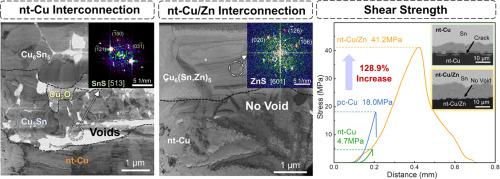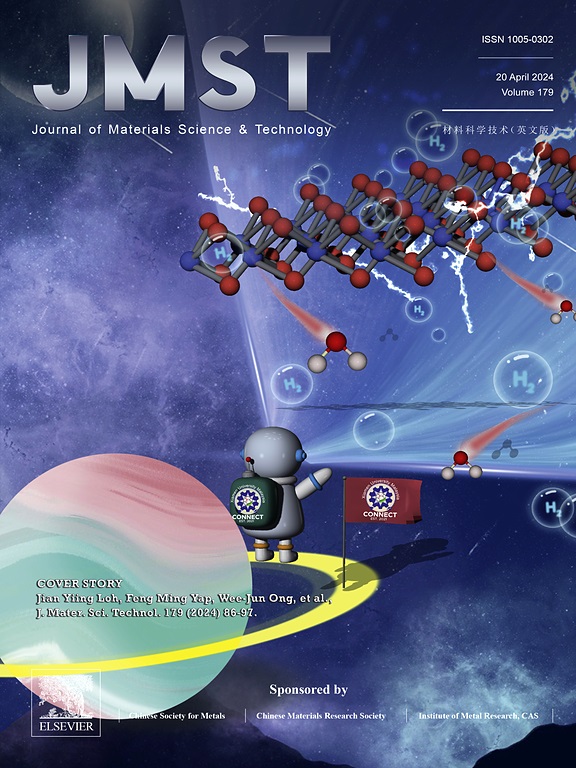Anchoring sulfur migration to mitigate Kirkendall voids in nano-twinned copper interconnections for robust and reliable packaging
IF 14.3
1区 材料科学
Q1 MATERIALS SCIENCE, MULTIDISCIPLINARY
引用次数: 0
Abstract
Nano-twinned copper (nt-Cu), with a preferred orientation, is highly promising as interconnect materials in high-density advanced packaging due to its considerable mechanical strength, excellent electrical conductivity, and resistance to thermal migration. However, its application is impeded by sulfur-containing byproducts from the electroplating process, exacerbating the formation of Kirkendall voids within solder joints during thermal aging. Herein, through the incorporation of Zinc (Zn) into the nt-Cu layer, we develop a nt-Cu/Zn composite structure. Our findings provide the first definitive confirmation of the mechanism by which sulfur atoms migrate to the Cu3Sn/nt-Cu interface through interstitial diffusion, thereby reducing the activation energy for vacancy formation. We further demonstrate that Zn effectively anchoring sulfur atoms, forming ZnS within the nt-Cu layer during heat treatment, which increases the vacancy formation energy and inhibits the development of Kirkendall voids. Remarkably, no Kirkendall voids are observed in the modified interconnects even after prolonged aging at 150°C for 1000 h. The nt-Cu/Zn composite metallization layers significantly decrease the growth rate of interfacial intermetallic compounds by 33.6% and enhance the shear strength of solder interconnections to 228.9%. This research underscores the potential of nt-Cu in advanced electronic packaging, offering new pathways for improving the power density and reliability of electronic devices.

锚定硫迁移以减轻纳米孪晶铜互连中的Kirkendall空洞,以实现坚固可靠的封装
纳米孪晶铜(nt-Cu)具有良好的机械强度、优异的导电性和抗热迁移性,是高密度先进封装中极有前途的互连材料。然而,它的应用受到电镀过程中含硫副产品的阻碍,在热老化过程中加剧了焊点内Kirkendall空洞的形成。在此,通过将锌(Zn)掺入nt-Cu层,我们开发了nt-Cu/Zn复合结构。我们的发现首次明确证实了硫原子通过间隙扩散迁移到Cu3Sn/nt-Cu界面的机制,从而降低了空位形成的活化能。我们进一步证明了Zn有效地锚定硫原子,在热处理过程中在nt-Cu层内形成ZnS,这增加了空位形成能并抑制了Kirkendall空洞的发展。值得注意的是,即使在150°C下延长时效1000 h后,在改性的连接点中也没有观察到Kirkendall空洞。nt-Cu/Zn复合金属化层使界面金属间化合物的生长率显著降低了33.6%,并使焊接连接点的剪切强度提高了228.9%。这项研究强调了nt-Cu在先进电子封装中的潜力,为提高电子器件的功率密度和可靠性提供了新的途径。
本文章由计算机程序翻译,如有差异,请以英文原文为准。
求助全文
约1分钟内获得全文
求助全文
来源期刊

Journal of Materials Science & Technology
工程技术-材料科学:综合
CiteScore
20.00
自引率
11.00%
发文量
995
审稿时长
13 days
期刊介绍:
Journal of Materials Science & Technology strives to promote global collaboration in the field of materials science and technology. It primarily publishes original research papers, invited review articles, letters, research notes, and summaries of scientific achievements. The journal covers a wide range of materials science and technology topics, including metallic materials, inorganic nonmetallic materials, and composite materials.
 求助内容:
求助内容: 应助结果提醒方式:
应助结果提醒方式:


